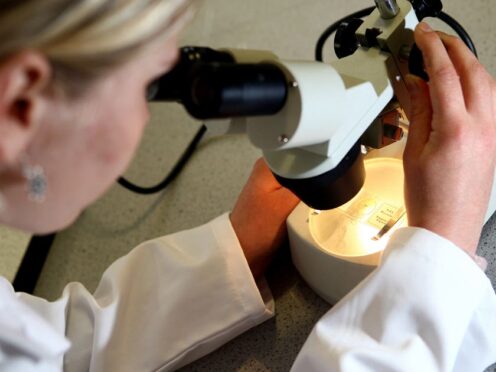
A treatment that targets cells that help tumours survive, rather than directly attacking cancer itself, could help prevent the growth and spread of breast cancer, according to a study.
Using immunotherapy to treat breast cancer “has had limited success”, researchers said, but their breakthrough could help “develop a more effective and targeted treatment” for the disease.
A team led by the Institute of Cancer Research, London, explored the potential of a type of immunotherapy known as Car-T.
As part of the treatment, T-cells – blood cells that protect the body from infection and disease – are genetically modified in a lab to make them better at killing cancer and returned to the blood.
In England, Car-T is offered on the NHS to children and young people with certain blood cancers, and is also recommended to adults with types of non-Hodgkin lymphoma (NHL).
Researchers said use of the therapy on solid cancers “remains a challenge” due to a lack of antigens that are unique to tumour cells.
To overcome this, they targeted the treatment at cells surrounding the tumour’s blood supply, which make a protein known as endosialin.
Using mice, the team found targeting the protein disrupted the tumour’s blood supply and stopped it from growing or spreading.
Dr Frances Turrell, postdoctoral training fellow in the division of breast cancer research at the Institute of Cancer Research, London, said: “This is the very first study that demonstrates the effectiveness of using endosialin-directed Car-T cells to reduce breast cancer tumour growth and spread.
“Immunotherapy has had limited success in treating breast cancer but by targeting the cells that support the tumour and help it to survive, rather than the cancer cells directly, we’ve found a promising way to overcome the challenges posed by the tumour environment and develop a more effective and targeted treatment for breast cancer.”
The team also tested the treatment on lung cancer tumours in mice and recorded similar results. They are now working on developing it further, with the hope it can be used in clinical trials.
The study was funded by Breast Cancer Now.
Dr Simon Vincent, director of research, support and influencing at the charity, said the findings, published in The Journal for ImmunoTherapy of Cancer, “could lead to much-needed targeted treatments for people with breast cancer”.
According to Breast Cancer Now, about 11,500 women and 85 men die from the disease in the UK every year, the equivalent to one every 45 minutes.
Dr Vincent added: “Now we know that the treatment works in principle in mice, Breast Cancer Now researchers can continue to develop this immunotherapy to make it suitable for people, as well as to understand the full effect it could have and who it may benefit the most.”
Dr Turrell said: “We could not have done this project without funding to the molecular cell biology group from Breast Cancer Now and we hope that further research will help translate these findings into targeted therapies for breast cancer patients.”

Enjoy the convenience of having The Sunday Post delivered as a digital ePaper straight to your smartphone, tablet or computer.
Subscribe for only £5.49 a month and enjoy all the benefits of the printed paper as a digital replica.
Subscribe